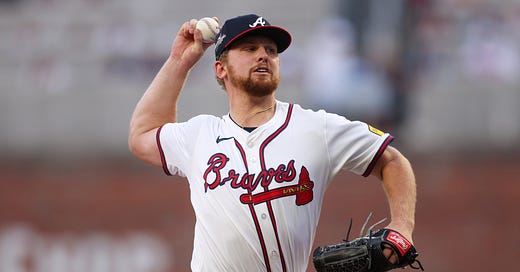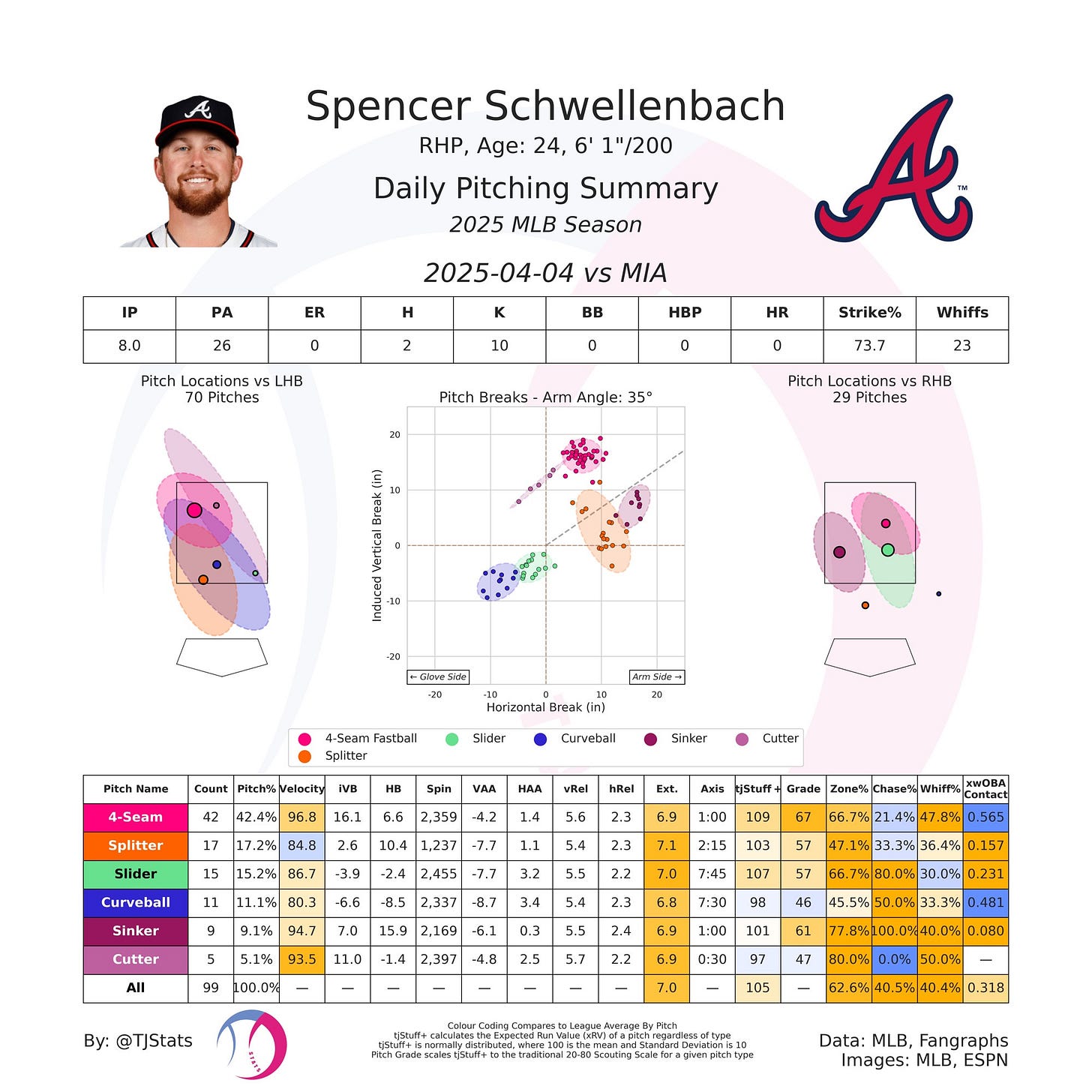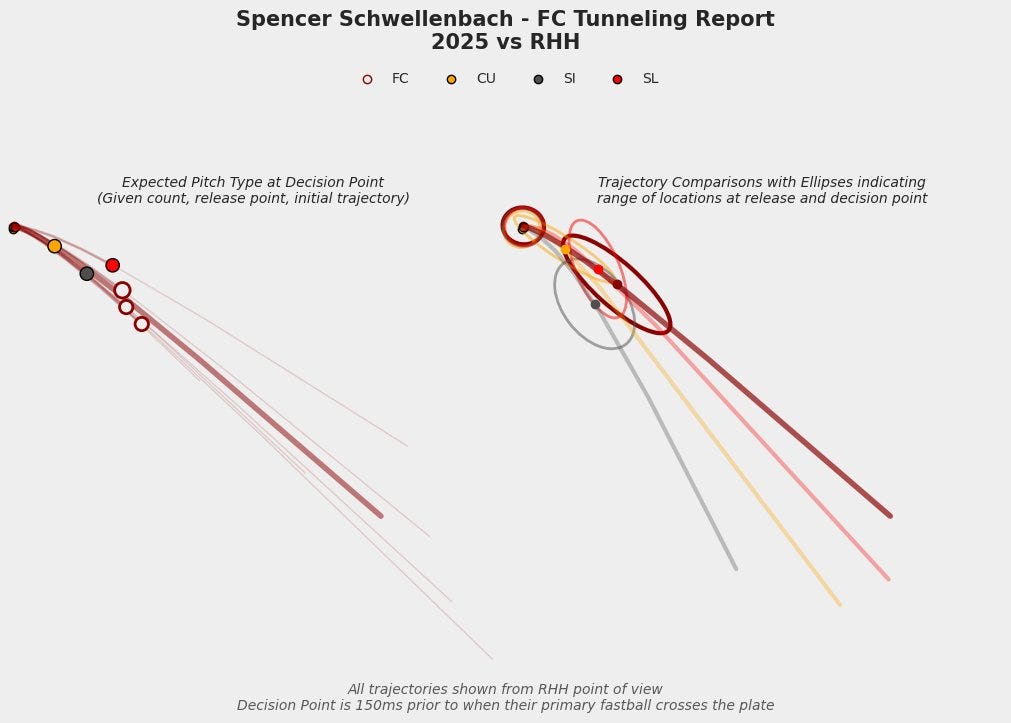Spencer Schwellenbach's so good because he's so unpredictable
Atlanta's other dominant young 'Spencer S' doesn't get enough credit for the depth of his arsenal
Stop me if you’ve heard this before, but the Atlanta Braves have a “Spencer S” around the top of the Cy Young leaderboards. Several sportsbooks have adjusted the National League odds - while Paul Skenes is still the favorite (+210) and Zack Wheeler still has the second-best odds (+550), Spencer Schwellenbach has now ascended to the third-best odds in the NL at around +650.
And based solely on results, I get it. He’s 1-0 with fourteen scoreless innings on the season. He’s allowed just three hits and walked one while striking out fourteen.
And the basics of who Spencer Schwellebach is are known - he’s got good velocity and great control.
But there’s another factor that we’re not properly giving him credit for: His unpredictability.
Let’s talk about it.
Part of this is the size of his arsenal
Schwellenbach throws six pitches, and they’re all at least average, if not above average:
Four-seam fastball
Splitter
Splitter
Curveball
Sinker
Cutter
Those of you who have been here since day one know that my favorite things when it comes to pitchers are throwing multiple fastballs, throwing multiple sliders, and throwing your slider > 85 mph.
He’s got both one and three, and give him one more offseason and he probably breaks out number two.
But the usage is another factor here: outside of the four-seamer, sitting at 41.2% usage, nothing is being thrown more than 20% or less than 10% of the time. While there are some platoon factors here, like the curveball usage being 80% slanted towards lefties and the sinker being exclusively an RHH pitch, for the most part it’s a three-pitch arsenal either way.
But this isn’t just the size of the arsenal, it’s also the pitch movements that contribute to this deception.
Spencer’s arsenal interactions are elite
This is a new term for the newsletter, so let me explain.
Pitches don’t exist in a vacuum. Their success, or lack thereof, are reliant on how they interact with the rest of your arsenal. This is where the concept of tunneling comes in - if everything looks the same out of the hand, but diverges in opposite directions halfway through the ball’s flight to the plate, it’s incredibly hard for a hitter to do anything but pick one ahead of time and hope they guessed right.
And Schwellenbach excels at the tunneling. Here’s an example of his fastball and splitter looking identical until halfway to the plate, where the splitter drops off the table.
But just the vibes and highlight clips aren’t enough, because we can quantify this. Baseball Prospectus now has Arsenal metrics that break down a lot of these interactions and provide some context and explanation for what’s making this work.
Subscription break! We’re adding more premium subs every single day - shout out to our newest premium subscribers from Wednesday: Mark, who upgraded from a free to a monthly sub, and James, who signed up for an annual sub. If you’re a frequent reader and/or find yourself really appreciating what we do both here and on the YouTube channel, which includes daily podcasts and video of media availabilities, why not become a paying member? It’s $6/month or $69 a year, and it helps support everything we’re going over here on Braves Today.
For instance, here’s Schwellenbach’s cutter and how it blends at release with the sinker, slider, and curveball:
Breaking this down simply, the left side of the image shows what the pitches look like they’re going to do at the point you need to decide as a hitter whether or not to swing. The right side shows where they actually end up by the time they get to the plate - all in different locations.
And the cutter blending well absolutely tracks - a cutter has elements of a slider, featuring some cut but not as much break or drop as a slider would. It’s commonly called a bridge pitch because it ends up being in between the fastball and slider on a pitch plot.
It’s not just the cutter to righties, by the way - the cutter blends with the four-seamer to lefties, while the slider blends with the fastball and splitter to both lefties and righties.
He’s also improved the movement profile of a lot of his pitches, as well. From last season to this season, he’s added an inch and a half of armside run to the sinker as well as ticking the velocity up to 95.5. His four-seam fastball is up a full mph while also picking up an inch and a half of IVB, from 13.4 to 15.9. The cutter has less drop and more horizontal cut, taking it above average movement-wise in both respects, while the slider continues to be an outlier on the pitch plot for its movement.
Here’s the typical Statcast plot - see how there’s a shaded circle for each pitch? That’s where the average MLB pitch of that type ends up, with the solid dots representing where Schwelly’s end up.
The worst place you can be is the center of that shaded circle, because that means your pitch ended up exactly where the hitter expects that type of pitch to end up.
Let’s go over the movement changes I mentioned above and think about them in the context of this chart:
Extra armside run on the sinker (orange) - taking it from the middle towards the outside of the circle
Extra backspin on the four-seam (red) - pushing him from the bottom left quadrant of the circle to more extreme left edge
Extra cut and less drop on the cutter (brown) - pushing him from the center of the circle to the very top
The splitter and slider aren’t fundamentally different this year…but they were already some of his best-scoring pitches on Stuff+, so leaving them alone was the right approach here. The curveball usually ends up towards the top of the blue circle when it’s executed well. No need to change that one, but some tightening of the release wouldn’t be the worst thing in the world.
This doesn’t even get to the velocity differences, but that’s obviously a big deal as well - try to sit on a slider at 87 and you likely can’t even adjust in time for the cutter at 94, never mind the heater at 97. Even if you’re expecting something soft, there’s a big difference in an 85 mph splitter and an 80 mph curveball. So on and so forth.
Combining these directional variations with the exceptional control and velocity spreads of this arsenal gives you literally everything you could want in a pitcher: All four directions are covered, he has multiple velocity bands, and he can put any of those pitches exactly where he wants them.
For my money, he’s the best young starter in the game not named Paul Skenes. And getting to watch him everyday is an absolute treat.
BONUS CONTENT: I broke down the case to extend Schwellenbach back in October - give it a watch, if so inclined.







Awesome work!